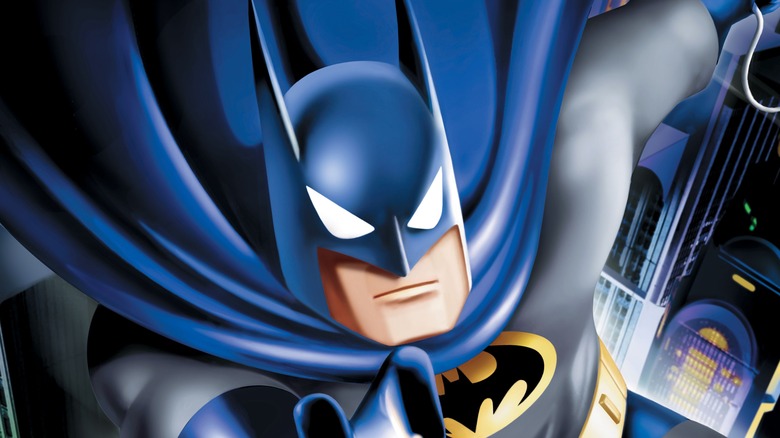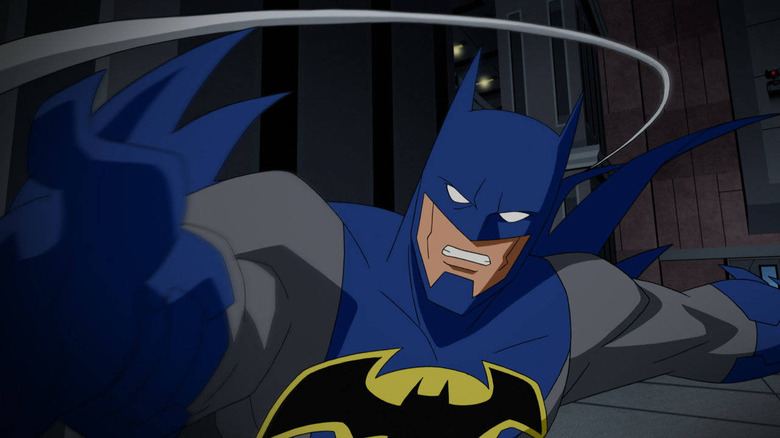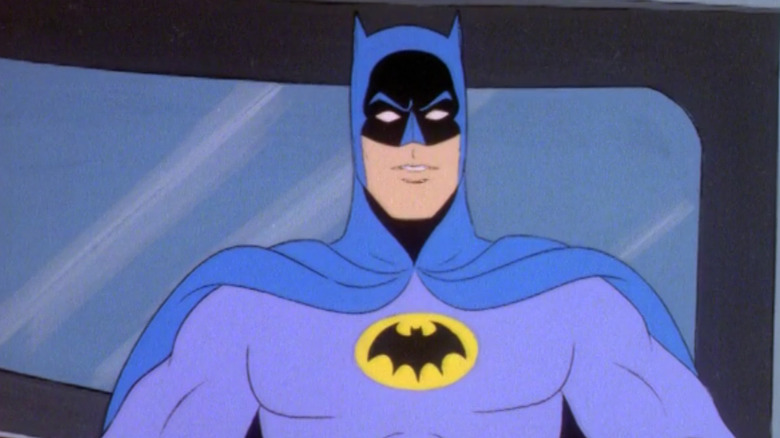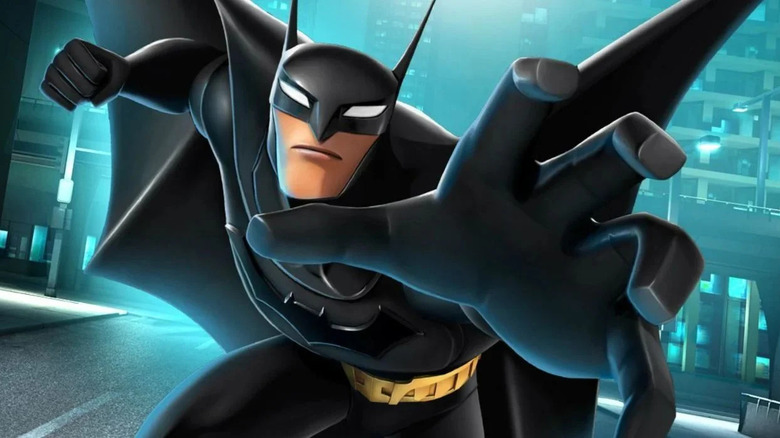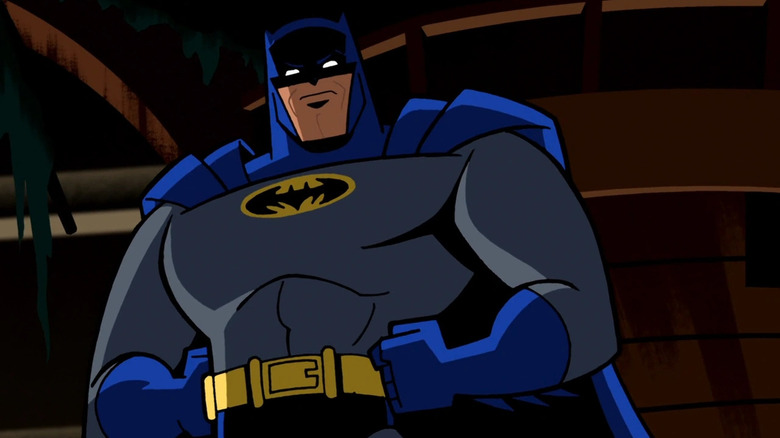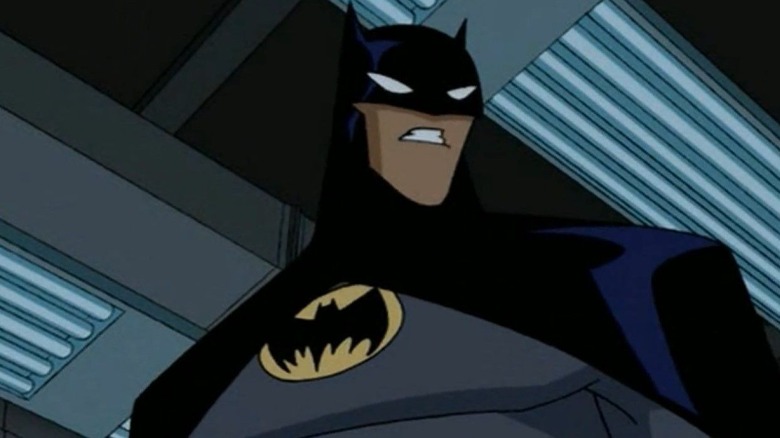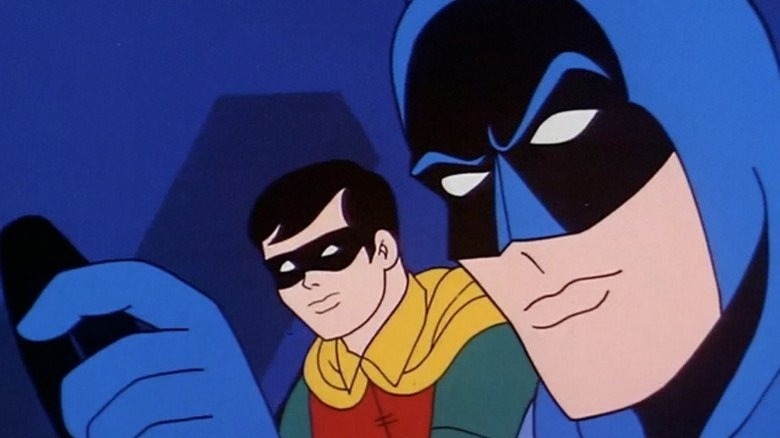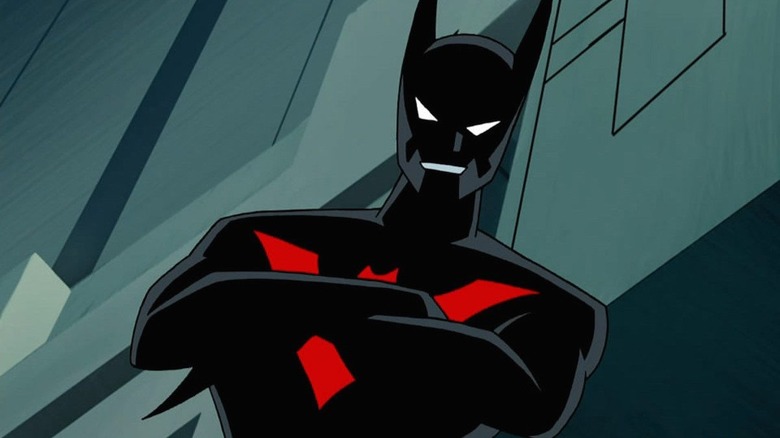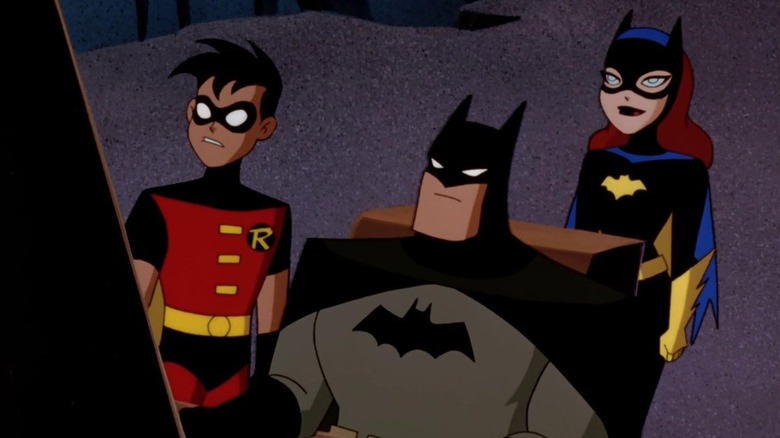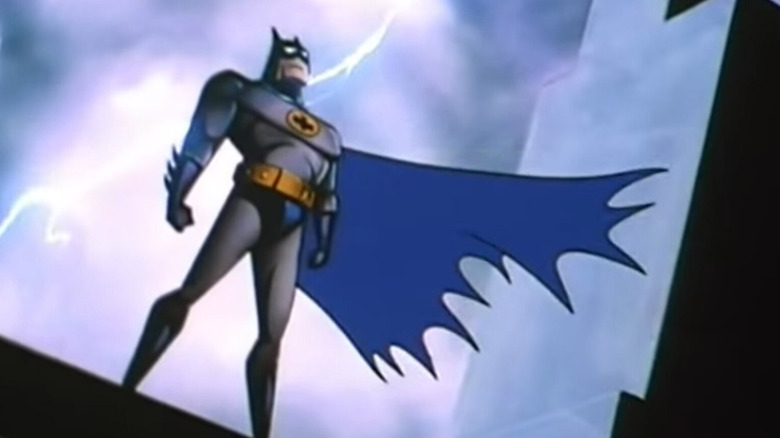Every Batman Animated Series Ranked
One of the most iconic superheroes of all time, Batman has proved time and time again to be a perfect timeless hero for kids and adults, and he ranks among the most highly represented outside of the comic book page, on screens big, small, and beyond. From his first black & white television serial in 1943 — just four years after his first appearance in "Detective Comics" #27 — to Matt Reeves' 2022 film, "The Batman," Bruce Wayne's Dark Knight has been featured in countless films, television shows, and even stage plays. But Batman has seen more action in animation than any other medium, with dozens of theatrical and direct-to-video releases, guest spots on other cartoons, appearances in team-ups like "The Super Friends" and "Justice League," and of course, a variety of his own animated series.
The most memorable of course is the landmark 1992 production "Batman: The Animated Series" from creators Bruce Timm, Paul Dini, and Alan Burnett, which redefined both Batman and kids animation for a new era. But before and since, Batman has headlined several highly rated animated shows, as well as a few not-so-memorable ones. So far there have been a total of nine solo Batman animated series, with a wide range of quality, good to bad. Some have proved enduring and timeless, others better left in the past.
With a new animated series on the horizon, "Batman: The Caped Crusader," it's time we looked back and ranked every Batman animated series. Will the legendary 1992 series top our list? Or will some other favorite surprise you as our number one pick? Keep scrolling on to find out how they shake out.
Batman Unlimited (2016)
Airing exclusively on DC Entertainment's YouTube Channel beginning in 2015, the web-based animated series "Batman Unlimited" was a series of animated shorts that, despite its web-based format, were as high quality as any series on this list in terms of production value (and definitely better than a few in many respects). Spun off from a series of successful animated movies, the shorts featured a talented voice cast that included Oded Fehrer ("Star Trek: Discovery"), John Dimaggio ("Futurama"), Will Friedle ("Boy Meets World"), and — in a nice bit of continuity — Charlie Schlatter returned from his 1997 appearance as the Flash to voice the character once more.
But be warned: fans who are looking for a compelling or engaging story will likely be disappointed by the series, as its episodes run a scant 3 to 4 minutes, designed solely to promote the accompanying line of action figures released during the same time. Still, the series of short episodes were fun and entertaining. It provided a good platform to showcase some of DC's other heroes alongside Batman, including the likes of Green Arrow, The Flash, Nightwing, and even Red Robin as they faced off against Batman's many villains. Appearances by lesser baddies like Silverback, Solomon Grundy, and Cheetah made it worth watching, and a story that featured a rare appearance from Ace The Bathound helped make it more fun than perhaps it deserved to be. But with its short run time and flat stories, it still ranks at the bottom of the list.
The New Adventures Of Batman (1977)
Debuting nearly a decade after the live-action "Batman" show "The New Adventures Of Batman" resurrected the cast of the highly-rated series to voice the same roles in a new animated title from Filmation in 1977. While competing studio Hanna-Barbera was having success with "Super Friends" across the dial — which starred Batman, Superman, Wonder Woman, Aquaman, and others — Filmation's new series still managed to forge its own identity. Having Adam West and Burt Ward lending their considerable talents — and unmistakable voices — to Batman and Robin surely helped, and is perhaps a big reason it's still remembered so fondly. Like its predecessor, the animation quality for "The New Adventures of Batman" was still lacking even by the standards of the day — though it was a step up from their first attempt.
Nevertheless, the series succeeded for a brief single season by breaking Batman and his array of unique villains out from the wider setting of the team-up cartoon and giving the likes of The Joker, Catwoman, and The Riddler a chance to shine on their own in Gotham City. Important for being the first animated appearance of the impish creature and fan-favorite character "Bat-Mite," who appears in not one, but four of the series' sixteen episodes (and even teams up with Batman and Robin in a battle with Mr. Freeze) it's still probably most fondly remembered for the return of Adam West and Burt Ward, both of whom would return again in a pair of animated movies in 2016 and 2017.
Beware The Batman (2013)
"Beware The Batman" was the fourth series for the Dark Knight in the 2000s, after "Batman Beyond," "The Batman," and "Batman: Brave & The Bold," and began airing just two years after the end of the latter series. While "Brave & The Bold" had been aimed squarely at children, this time producers attempted to craft a mix of mature stories while still giving it a family-friendly context. Unfortunately, audiences didn't seem to respond, and the magical mixture that helped "Batman: The Animated Series" become such a phenomenon continued to elude creators. The series was pulled after just 11 of its 26 episodes had been broadcast. Cartoon network would burn through the remaining 15 episodes with a brief run of 3 AM airings as part of their late-night Toonami lineup. Despite this, some believe it received more criticism than it perhaps deserved (via Cbr.com).
"Beware The Batman" focused on Bruce Wayne's early days as the Caped Crusader, battling criminal elements in Gotham City's underworld. It notably departed from standard 2D visuals and opted for heavily stylized computer animation. Though it was a bold decision, it didn't quite live up to its potential, as some fans have called the animation rubbery, and reminiscent of late 1990's video game cut scenes, rather than the kind of high-quality art seen in the best Batman cartoons. To its credit, the show managed to mix in a variety of lesser-known supporting characters as Batman was paired with the sword-wielding Katana in his fight against villains like Anarky, Magpie, and Lady Shiva. For all it did right though, it's still one of the more forgettable series on this list.
Batman: Brave & The Bold (2008)
As "The Batman" was winding down its 65 episode run in early 2008, the wheels were already in motion on its successor, "Batman: Brave & The Bold," which aired its first episode that very fall. Without skipping a beat, Batman was back on the air with an all-new animated series, this time targeting a much younger child audience than previous shows. Visually inspired by the 1950s comic books by Dick Sprang with brighter colors and more exaggerated proportions, the series also embraced a lighter tone and sillier gags that harkened back to classic comics of the era. But one conceit of the series that was a signature of its stories was the regular team-ups with other heroes, with nearly every episode featuring a guest appearance from one of DC Comics' pantheon of comic book superheroes.
Not quite a team dynamic, "Batman: Brave & The Bold" nonetheless gave kids the opportunity to meet new and diverse characters like Blue Beetle, Plastic Man, and the Metal Men, while going up against a wider variety of villains than any "Batman" series had showcased before. It was a clever way for WB to use Batman, one of their most popular characters, to introduce audiences to new ones. It was successful enough to spawn a long-running line of toys, and earn the series itself five seasons and 65 total episodes. In 2018, the series returned with a direct-to-DVD film where Batman teamed up with one of WB's other popular cartoon crimefighters, Scooby-Doo.
The Batman (2004)
After an elderly Bruce Wayne had appeared for three seasons on the futurist "Batman Beyond," and a prime era Batman had spent three more years as a member of a superhero team in "Justice League," DC and Warner Bros. launched "The Batman" in 2004. It was the first solo series for Bruce Wayne's Caped Crusader since 1997 and ran concurrently with the sequel team-up series "Justice League Unlimited" where the Dark Knight continued to play a considerable role. Meanwhile, this new Batman show was a departure from previous versions, with an all-new voice cast that didn't include Kevin Conroy, who had performed the role of Batman in every animated version since 1992. Chronicling Batman's early years, "The Batman" begins in a time when most of Gotham City still doesn't believe The Batman exists, and the hero has few allies.
A wildly different series than many expected after years of Bruce Timm's version of Batman, the show did manage to carry forward most of the same popular heroes and villains, but reimagined them with a new animation style that boasted a unique visual design. Its style and tone had a very early 2000's "extreme" aesthetic that — while dated — still holds up surprisingly well nearly two decades on. Originally airing on Kids WB, it shifted over to Cartoon Network in its second season and proved a hit with kids during its first run. The move to CN was successful, and the show was the winner of six Daytime Emmy Awards. It brought home the 2006 trophy for Outstanding Special Class Animated Program, and remains one of the more fondly remembered animated shows for the hero.
Batman & Robin The Boy Wonder (1968)
The first ever animated adaptation of the Caped Crusader, "Batman & Robin: The Boy Wonder" has gone by a few different names, including "The Adventures of Batman," likely because it was part of an hour block of programming alongside the Man of Steel called "The Batman/Superman Hour," and thus didn't actually have its own title. Whatever its true name, it proved to be a relatively faithful adaptation of the characters for their time, and began airing not long after the conclusion of the 1966 "Batman" live-action TV series. "The Batman/Superman Hour" actually began life a year before with "The Superman/Aquaman" hour and proved to be a big hit for the studio Filmation. As a result, and with Fox's deal for "Batman" over after the live-action "Batman" series ended, CBS secured the rights to add Batman to their animated mix, and the new show was born.
For some children this would be their first exposure to Batman and Robin. Hot off the heels of the live-action series, "Batman & Robin The Boy Wonder" included popular comic book heroes like Batgirl and Commissioner Gordon as prominent supporting characters, and all of Batman's best villains were there: The Joker, Penguin, The Riddler, Catwoman, and more. Though certainly dated by today's standards, the animation was colorful and fun, though Filmation was known for its heavy use of static imagery and marginal motion. The stories were simplistic, and cut down from the previous hour-long block of "Superman/Aquaman," each installment was a brief 13-14 minutes.
Batman Beyond (1999)
After "Batman: The Animated Series" and its sequel, "The New Adventures Of Batman," producers took a radical approach. Rather than continue the award-winning series with another new edition of the same characters, they'd jump ahead several decades and give audiences a glimpse of a new, futuristic Gotham City, protected by an all-new, younger and hipper techno-Batman. Fans at the time may not have wanted to tune in because it looked so different, but the new Batman's mentor was Bruce Wayne, voiced again by Kevin Conroy, and set in the same continuity as the two previous series, attracting longtime viewers. Far from the dumbed-down, edgier-but-emptier reboot that many might have expected, "Batman Beyond" proved itself a strong series on its own merits, rarely even relying on connections to the previous shows. New villains, new threats, and a new Gotham City were exciting and compelling in their own right, catapulting the series from underdog to hit.
Set in some 60 years past "Batman: The Animated Series," Bruce Wayne had retired and handed his company to a new owner, and long retired his Batman persona. But when a new threat arrives in Gotham, Wayne reemerges to take back control of his company, and hands the Batman mantle to Terry McGuinness, a new young hero with a troubled past not dissimilar to his own. Running three seasons and 52 episodes, it would be revisited in several stories as part of the team-up series "Justice League" and "Justice League Unlimited." This new version of Batman would prove popular enough that he'd even be introduced into official comic book continuity in 2010, ensuring his own unique legacy.
The New Batman Adventures (1997)
When "Batman: The Animated Series" ended in 1995, it wasn't due to poor ratings or lack of interest, but a desire from those involved to move on to something new before things got stale. In 1996, the same creative team would debut "Superman: The Animated Series," with a new streamlined art style, and even more action packed stories. With the Man of Steel's series a hit, it wasn't long before Batman got his own overhaul, with the revived series being reinvented as "The New Batman Adventures." Continuing several years after the last events seen in "Batman: The Animated Series," this new series moved the story forward in bold new ways, and with a sleeker look that matched "Superman: The Animated Series."
In "The New Batman Adventures" Robin has evolved into his own her, Nightwing, and Batman has been joined full time by Batgirl, and a new Robin — young Tim Drake. The series would cross over with the "Superman" series a few times, most memorably in the first meeting of Superman and Batman that occurred in the epic three-part episode, "World's Finest" that saw Lex Luthor and The Joker teaming up to take down Batman and Superman. The new series also made its own unique contributions to the Batman mythos, with the introduction of original villains like Roxy Rocket and Firefly, the latter of whom is played by Brendan Fraser in Matt Reeves' live-action film, "The Batman." Nearly as highly rated as its predecessor, "The New Batman Adventures" stands as a daring and largely successful attempt to redefine an already classic series.
Batman: The Animated Series (1992)
It might be hard to imagine now, but when "Batman: The Animated Series" first aired in 1992, there hadn't been a Batman cartoon in almost 15 years. From its very first episode, this new series broke the mold of the more light-hearted, poorly written, cheaply animated cartoons of the '80s like "He-Man" and "Transformers" that were designed mostly to peddle toys. Instead, it was impeccably crafted with high-quality animation, cinematic direction, and well-written, thoughtful stories — often with mature themes. It also boasted a quality of voice talent that was unusual for its time, and recruited Hollywood composer Shirley Walker to provide its dramatic score and famous theme song.
Suffice to say, "Batman: The Animated Series" was a trailblazer, and would go on to be nominated for 13 Prime Time Emmy Awards, winning four, including Outstanding Animated Program and Outstanding Writing in an Animated Program. Featuring a new vision for the Dark Knight, the series didn't just adapt DC's greatest vigilante and his rogue's gallery of classic villains, it reinvented much of the mythos for the series, and in some cases these versions of the characters have become the definitive takes. It also introduced villain turned anti-hero Harley Quinn, who has since become one of the company's biggest characters, and began voice actor Kevin Conroy's unprecedented run on Batman. The actor continued to voice him in animation, video games, and even played him in live-action. The series continues today, in the form of an audio drama featuring the same voice cast. It should come as no surprise to anyone that "Batman: The Animated Series" is the best Batman animated series, and will likely never be topped.
